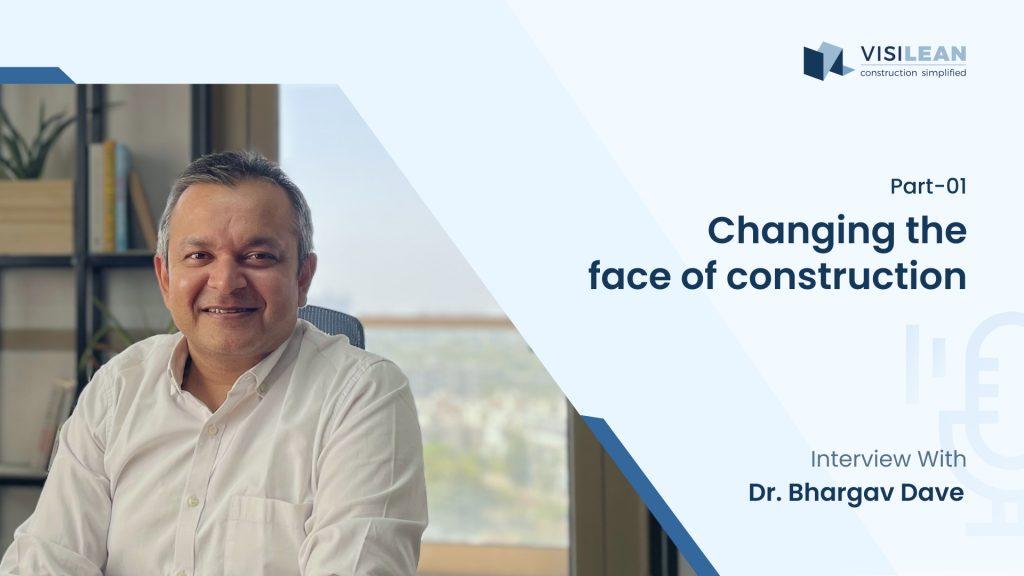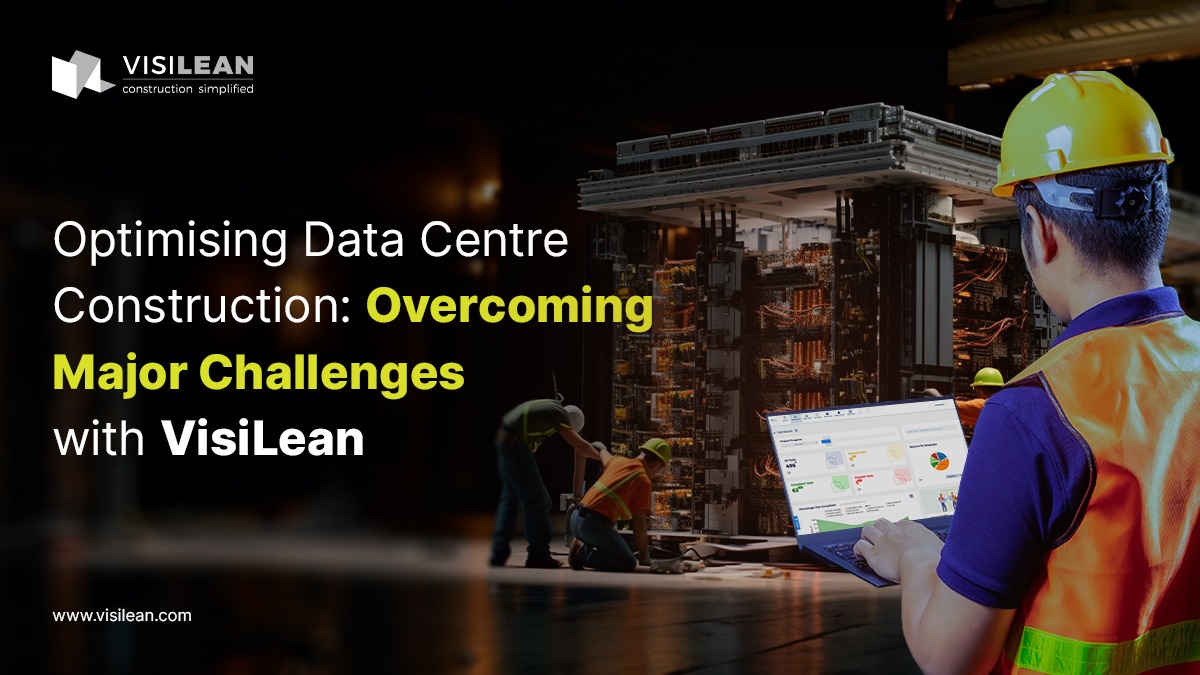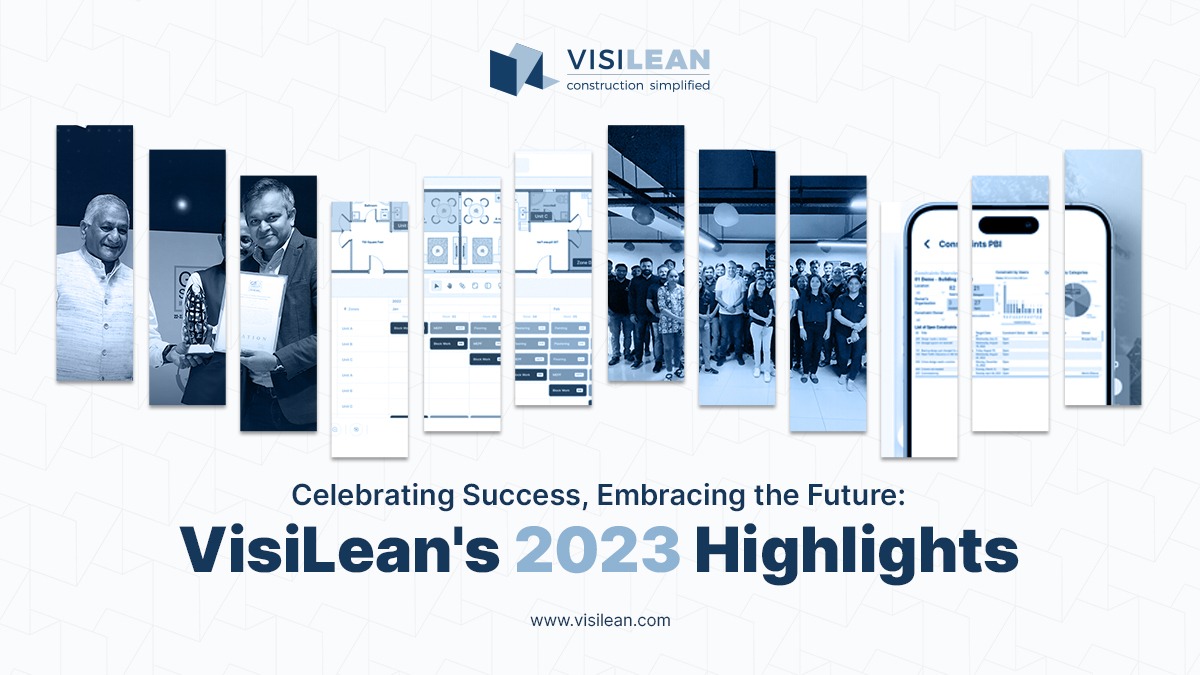We live in a world where digitalisation is the buzzword. While most of the other sectors embraced it quickly, the construction industry has so far remained an industry characterised by manual processes and traditional methods. But now, the industry is joining the bandwagon. It is in this scenario that companies like VisiLean are bringing about a dramatic transformation.
One of the pioneering companies integrating tech to find a solution for the issues you face at the worksite, VisiLean holds a special place. VisiLean is the only product in the construction sector that provides a lean production management workflow integrated with BIM. This innovative cloud-based lean production management service for the construction industry, developed from the ground up is a system for construction professionals and workers.
In a freewheeling chat, Dr. Bhargav Dave, the CEO of VisiLean, talks about his affinity for challenges, his tryst with problem-solving, and efficient integration of technology in construction – and how it all ties up with his VisiLean story.
So, how did it all begin?
Dr. Dave:
It is not surprising that children follow in the footsteps of their parents when it comes to choosing career paths. However, it is an amusing story when a family chooses to pursue the same career for generations. My story follows this script. I was born into a family of civil engineers, and we have a family business that goes back forty years! The best part about it was that I got a chance to be in the midst of things on a construction site while I was still a student. I could see, observe, and learn how a civil engineer worked in real life. I never missed a chance to visit my father’s projects. This also brought me in touch with the challenges that plagued the construction sites in those days. Each of these visits was an eye-opener. And these events, however small, were crafting the way I was evolving. Being an engineer, each of these events made me rethink my career. And then a chance to be associated with a flagship project in Gujarat, India while doing my bachelors changed it all.
This project was a private project with millions of rupees being spent on it. A lot was riding on the project. One would imagine a project, especially one of this magnitude, would be well planned. However, it was one of the most chaotic workplaces I have ever seen. Everything was in disarray. There were no proper communication channels in place. There was missing data, that often led us to build something only to be demolished the next day. There was a lot of waste, a lot of unnecessary tensions, and needless to say losses that could have been avoided. And what was worse, the work environment was very hostile.
Then came an incident that I still repeat to my students. One day, they were building a conveyor belt, and for some strange reason, the engineer did not have a structural drawing in place. The belt was to be housed in a set of columns. The engineer in charge made the structural drawing on a piece of paper in front of me. The conveyor belt was built according to this drawing. No planning, no collaboration, just continued chaos. This lack of coordination was just one of the issues the construction sector faced. It was normal for things to go wrong. It was equally normal for tempers to flare and a hostile environment to last endlessly.
This made me think. We already had half a dozen software solutions to design with, software for budgeting and auditing; so why not something to ease the pressures of construction? Why not have software in place to tackle real problems the construction site faces daily?
This was the year 2000 and I was still in my 4th year at Uni, and I was taking some programming courses on the side. For my 5th year thesis project, I decided to design something that could tackle the challenges I faced. I had zeroed in on logistics as one of the key concerns in those days. Construction sites, as you know, use many materials and there was a need to keep track of where the machinery was. You need to know where the excavators were to schedule the work for the next day, you needed to know if the steel was going to make it on time – and we did not have a way to track it. I designed and developed a system to solve this issue. And now, coming to think of it, the architecture I used to design this product is very similar to the one that VisiLean employs today. It was a four-tier web-based system that was ahead of its time as it was still 2000. This was where the seeds of VisiLean were sown.
I started working at a construction company (who had provided the use case for the thesis) and decided that I would try to find solutions for real issues based on real needs. It was around the same time that I decided I would not be part of my father’s business. It was not challenging enough for me. I wanted bigger problems to solve and there were plenty around me. Even though I was pivotal in implementing many new processes, I was restless. I wanted more.
The research, the Ph.D., and VisiLean –the evolution story
Dr. Dave:
I was hooked on designing systems. I was looking out for something more challenging. Those days, there was very little that happened in the construction industry in terms of digital systems. I broadened my search. I discovered that there were some researchers working in that area – albeit in very small pockets. I discovered a small group of people working in a similar area at the University of Salford (Manchester) in the UK and I decided to take up my Masters in the country. After my Masters, I found a job in a reputed company in the UK.
The company I worked with was going to deploy an IT system that digitalised its processes. My job was to see how we could improve the processes involved alongside the IT system. It was interesting and challenging at first, but soon I realised that the systems on their own were not solving the actual issues that construction workers faced. We were solving issues for those who were sitting in the cosy head office, such as accounting, estimating, or payroll. We were not focusing on how we could make the on-site construction process any better. The industry was still struggling, the companies, even those that had a system in place, were not seeing profits as expected. The interface issues between head office and sites were brushed under the carpet.
I was frustrated and decided to head back to the University for more research and do my Ph.D. This became another milestone in my life. It was at Salford Centre for Research and Innovation (SCRI) that I met Prof. Lauri Koskela, one of the pioneers of Lean Construction, and the founding father of the International Group for Lean Construction (IGLC). I wore multiple hats those days – that of a researcher, and a Ph.D. scholar all rolled into one! I needed a solution to the problem that construction workers faced.
We decided to focus on improving construction in general from a production perspective. I went around meticulously collecting data, documenting it, and identifying problems that needed solutions. I would then systematically analyse the steps to come up with a process.
During this journey, we discovered that to construct efficiently you needed to answer two critical questions about production – that of “what” you are building (i.e. information about the product) and “how” you are going to build it (information about the process). We designed VisiLean as a means to construct something from the ground up, to address the very basic problems that any construction site would face. I was so passionate about this that even water cooler conversations would spark new ideas. It was during one of these conversations with a fellow researcher that I stumbled upon a production visualisation method that he was working on. And then, just like that, I saw the light! If we could build a highly visual digital platform that helps people manage projects, it could be easy for everyone to follow.
The search for someone who could build that system for me led to Stefan Boddy (our current CTO). We built a prototype in 2009 – 2010. At this stage, we were not thinking about commercialising our product. We were working on it from a pure research perspective. We were just solving a problem that we had found. After building the prototype we started meeting people from the industry. Salford’s Centre for Research and Innovation (SCRI) at the time was one of the leading centres in the field of built environment globally. We had easy access to industry leaders. We used to demonstrate our prototype to the industry majors. They would give us critical feedback on which we would then work. Most of the companies we spoke to told us that VisiLean offered the solution they were looking for. For us, it was still a prototype that needed iterations. However, this led us to think about commercialising VisiLean.
I had finished my Ph.D. in 2013 and I decided to move to Finland. We had another project with Prof. Lauri Koskela at Aalto University, and we were thinking that we would spend the next three years in Finland and try to improve VisiLean. Finland also offered the best environment for start-ups. The government had various funding instruments that were aimed at funding promising and innovative start-ups. I came to know about a government initiative aimed at funding research ideas called ‘TUTL (Commercialising Research Ideas)’. I grabbed the opportunity. In its second year, the project was very competitive. We were lucky to get selected and that marked the dawn of what you see now. We were awarded just over half a million Euros to fund the project and develop the idea further. We refined the product and in 2015 VisiLean was founded. Stefan and I alongside Martin who had a background in product management and commercialisation became the founding team. Prof. Koskela and Sacks who had guided me throughout this journey assumed the position of advisors. Through these years, we have worked as a remarkable team and that is how VisiLean came to be.
Advisors, core team – how did you meet them, how did the whole team come together?
Dr. Dave:
One of the most influential people I have come across in my life is Prof. Lauri Koskela. He was my Ph.D. supervisor. A pioneer in lean construction management, he is a very famous academic. He is an academic superstar, a stalwart, someone that academia and industry looked up to. Being associated with him, I was blessed with a kind of academic circle that comprised big names. I could meet and interact with the industry leaders without having to wait for an appointment. I could bypass the long queues to meet them, to interact with them, to learn, and to grow. And I grabbed every available opportunity. I was introduced to Prof. Rafael Sacks, by Prof. Koskela while I was doing my research. One of the brightest minds I have come across, Rafael is an MIT and Technion Alum who is an international expert on the synergies of BIM and Lean construction. We have co-authored papers and conducted many workshops together. I hold him in high esteem too and yes, that is the main reason that they are my advisors. Both Dr. Lauri and Dr. Rafael are people who have been instrumental in my career.
Stefan Boddy and I go back to our university days. When I was still working on the product, I needed the help of someone who could build the product. The research center manager pointed me to Stefan who was working at the same center. I approached him and he was equally enthusiastic. We got to work on the product together. It is an association I value greatly too. He is now the CTO of the company.
I met Martin Zilliacus after moving to Finland. I wanted someone who knew the country, the start-up environment, and Martin was a perfect fit. He has extensive experience in product management, commercialisation and he has been a tremendous team player. He is the COO of the company now.
When we started the company, we did not have any designations in mind, these designations were part of our evolution too. We are now a team that works from three countries – and is growing each day.
So, what is VisiLean today?
Dr. Dave:
VisiLean the company, functions out of three countries and works across 15 countries. VisiLean, the product is an innovative cloud-based lean production management service for the construction industry. Developed from the ground up as a system for construction professionals and workers, it supports synchronous visualisation of process and product. It is the only product in the construction sector that provides a production management workflow integrated with BIM.
To be continued..
This is part one of the interview with Dr. Bhargav Dave. Stay tuned for part two where he discusses how VisiLean functions and the future plans.
Want to know more about us? Head to https://youtu.be/vALoybf0zpM, or visit our website, https://visilean.com to learn about all our features!







